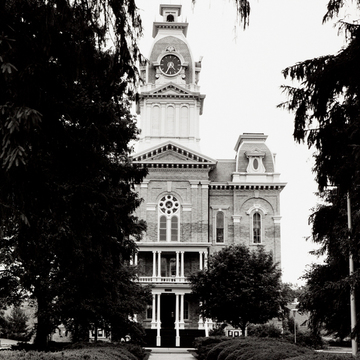Established in Spring Arbor in 1844 by a group of Free Will Baptists as Michigan Central College, the school was moved to Hillsdale in 1853. Because it was on the line of the Lake Shore and Michigan Southern Railroad and because its citizens raised $30,000 for building, Hillsdale was more attractive. Five adjoining buildings were erected between 1853 and 1854 on a hill north of town with a view of the city and the surrounding countryside, but most were destroyed by fire in 1874. The trustees then adopted a plan to rebuild five disconnected buildings on the center of the twenty-five-acre, tree-shaded park known as College Hill. Brush and Smith of Detroit, with F. M. Hollowell as the superintending architect, designed Central Hall as the centerpiece of a group of brick buildings arranged around three sides of a quadrangle and facing south. Central Hall is one of three that remain. The others are the Fine Arts Hall on the east and Knowlton Hall on the west. This glorious Second Empire administration building followed closely the popular style of the time and has a central, attenuated, convex-roofed clock tower, with matching towers at the front corners that are seen from all directions. Except for its mansard roofs, the main part of the building is Italianate and matches the other surviving buildings that form the group. Slender columns support the porch and also seem to support the colossal pilasters of the central pavilion. H. Richard and G. W. Mickle Builders of Jackson constructed Central Hall. An addition to the north entrance renovated a twelve-hundred-square-foot porch.
You are here
Central Hall, Hillsdale College
If SAH Archipedia has been useful to you, please consider supporting it.
SAH Archipedia tells the story of the United States through its buildings, landscapes, and cities. This freely available resource empowers the public with authoritative knowledge that deepens their understanding and appreciation of the built environment. But the Society of Architectural Historians, which created SAH Archipedia with University of Virginia Press, needs your support to maintain the high-caliber research, writing, photography, cartography, editing, design, and programming that make SAH Archipedia a trusted online resource available to all who value the history of place, heritage tourism, and learning.





